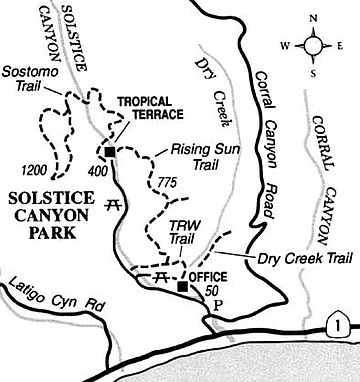 Facebook
Facebook
 X
X
 Instagram
Instagram
 TikTok
TikTok
 Youtube
Youtube
Solstice Canyon Park, a unit of the sprawling Santa Monica Mountains National Recreation Area, invites your attention, with superb oak woodland habitat to enjoy, and lessons in fire ecology to ponder. Since its unveiling in 1988, these 556 acres have turned into a hiker's showplace. Old buildings have been restored, junk has been hauled away, weedy plants have been replaced by native ones, trails have been cut, and old roads have been either revegetated or incorporated into the trail system. Except for the ruins of the architecturally noted "Tropical Terrace" home built by the previous owners of the property (the Roberts family), not much remains of the devastation wrought by a 1982 fire that burned large sections of Malibu.
The gateway for Solstice Canyon Park lies along Corral Canyon Road, 0.2 mile north of Pacific Coast Highway (Highway 1) in west Malibu. There are a few parking spaces at this gateway and more room for parking a short distance inside.
Several hikes are possible in the park, ranging from easy to moderately strenuous. The Dry Creek Trail heads north up an oak-shaded ravine for about 0.6 mile, offering a view of a 100+ foot precipice that on rare occasions becomes a spectacular waterfall. The mile-long TRW Trail loops along a hillside containing a silo-shaped building formerly used by TRW Inc. as a test facility for satellite instrumentation.
The main route for visitors, however, is the paved Solstice Canyon Trail (suitable for bicycles and wheelchairs in addition to travel by foot), which leads straight up Solstice Canyon to the ruins of Tropical Terrace. All along the way you'll enjoy a fantastic woodland of sycamore, bay, and live oaks -- the latter with trunks up to 18 feet in circumference.
You'll pass a circa 1865 stone cottage on the right, the oldest existing stone building in Malibu, now used as a staff residence. Next is a picnic area nestled alongside the melodious creek. The stream in Solstice Canyon occasionally supports steelhead trout runs.
After a distance of about 1.5 miles you arrive at the remains of Tropical Terrace. In a setting of palms and giant birds-of-paradise, curved flagstone steps sweep toward the roofless remains of what was for 26 years one of Malibu's grand homes. Beyond the house, crumbling stone steps and pathways lead to what used to be elaborately decorated rock grottoes, and a small waterfall. Large chunks of sandstone have cleaved from the canyon walls, adding to the rubble. For all its perfectly natural setting, Tropical Terrace's destiny was that of a temporary paradise, defenseless against both fire and flood. This was underscored yet again when a fire last January raged near here, chasing people from their homes and closing the park for several months.


Solstice Canyon Park, a unit of the sprawling Santa Monica Mountains National Recreation Area, invites your attention, with superb oak woodland habitat to enjoy, and lessons in fire ecology to ponder. Since its unveiling in 1988, these 556 acres have turned into a hiker's showplace. Old buildings have been restored, junk has been hauled away, weedy plants have been replaced by native ones, trails have been cut, and old roads have been either revegetated or incorporated into the trail system. Except for the ruins of the architecturally noted "Tropical Terrace" home built by the previous owners of the property (the Roberts family), not much remains of the devastation wrought by a 1982 fire that burned large sections of Malibu.
The gateway for Solstice Canyon Park lies along Corral Canyon Road, 0.2 mile north of Pacific Coast Highway (Highway 1) in west Malibu. There are a few parking spaces at this gateway and more room for parking a short distance inside.
Several hikes are possible in the park, ranging from easy to moderately strenuous. The Dry Creek Trail heads north up an oak-shaded ravine for about 0.6 mile, offering a view of a 100+ foot precipice that on rare occasions becomes a spectacular waterfall. The mile-long TRW Trail loops along a hillside containing a silo-shaped building formerly used by TRW Inc. as a test facility for satellite instrumentation.
The main route for visitors, however, is the paved Solstice Canyon Trail (suitable for bicycles and wheelchairs in addition to travel by foot), which leads straight up Solstice Canyon to the ruins of Tropical Terrace. All along the way you'll enjoy a fantastic woodland of sycamore, bay, and live oaks -- the latter with trunks up to 18 feet in circumference.
You'll pass a circa 1865 stone cottage on the right, the oldest existing stone building in Malibu, now used as a staff residence. Next is a picnic area nestled alongside the melodious creek. The stream in Solstice Canyon occasionally supports steelhead trout runs.
After a distance of about 1.5 miles you arrive at the remains of Tropical Terrace. In a setting of palms and giant birds-of-paradise, curved flagstone steps sweep toward the roofless remains of what was for 26 years one of Malibu's grand homes. Beyond the house, crumbling stone steps and pathways lead to what used to be elaborately decorated rock grottoes, and a small waterfall. Large chunks of sandstone have cleaved from the canyon walls, adding to the rubble. For all its perfectly natural setting, Tropical Terrace's destiny was that of a temporary paradise, defenseless against both fire and flood. This was underscored yet again when a fire last January raged near here, chasing people from their homes and closing the park for several months.
